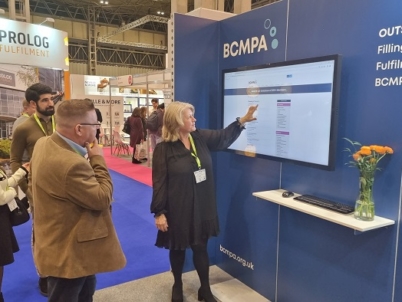-
Nutrivend selects Forterro’s Orderwise to support online expansion and streamline operations - April 11, 2025
-
ARROWXL LAUNCHES AMBITIOUS ZERO WASTE ROADMAP - April 8, 2025
-
THE BCMPA’S NEW CAMPAIGN DRIVES OUTSOURCING SUCCESS IN Q1 - April 7, 2025
-
BLACKOUT TECHNOLOGIES TARGETS TELEMATICS-INTEGRATED MOBILE DEVICE BLOCKING TO COMBAT SMARTPHONE DISTRACTION - April 1, 2025
-
OpenADR Alliance announces first OpenADR 3.0 certified products with EVoke Systems, E.ON Energy and Universal Devices - March 25, 2025
-
Growing fulfilment and contract packer appoints new Managing Director - March 25, 2025
-
When is it time to invest in a WMS? Understanding the key trigger points - March 25, 2025
-
eCapital helps Vantage Recruitment on its journey to financial success - March 24, 2025
-
Hugo Beck Celebrates 70 Years of Packaging Innovation with Open House Events - March 20, 2025
-
PROLOG FULFILMENT SUPPORTS LUNA DAILY’S COMMITMENT TO BETTER BODY CARE FOR ALL WOMEN - March 19, 2025
Philip King FCICM, former Small Business Commissioner and advisor to PKF Littlejohn Advisory, believes a ‘back to basics’ approach would help many businesses in the construction sector overcome the late-payment challenge.
Businesses across all sectors are under pressure. One only has to look at the number of failures in the manufacturing industry to know this to be the case. In fact, in the last quarter alone, the sector comprised just over 7% of the quarter’s total figure for all businesses. The recent closure of Kellogg’s Manchester site, the failure of the world’s largest solar manufacturer, Longi and the closure of manufacturer-turned-retailer Oak FurnitureLand further proves the point.
It is an established fact that companies often become insolvent not because they are inherently bad businesses, but simply because they run out of cash. Poor cashflow management, compounded by bad debts, high material costs, a restricted supply chain and slow paying customers, are typically to blame.
But while it is tempting to lay the blame wholly on late payment, businesses must shoulder some of the responsibility for their own poor credit management practices. Put another way, best practice credit management can limit the amount to which a business finds itself financially vulnerable.
So how can bad debts be avoided, and payments accelerated? Much can be achieved by getting back to basics and doing the basics well.
Know your customer
First and foremost, even the most basic checks can avoid potential embarrassment later. Know your customer (KYC) should be the mantra of every director, every sales executive, and every individual in your credit team. How well do you know the company you are dealing with? What is their Company Registration Number? Do they even have one? What is their legal status? Are they a limited company? A Partnership? A PLC? LLP? All such information is important, not least to ensure you invoice the correct legal entity at the point your product/service has been delivered.
Using data from reputable credit reference agencies is always advised to supplement the information stored at Companies House. This enables you to dig deeper and get beneath the company itself. It will help you determine the amount of credit you want to extend, especially since their success and survival may depend on the stability of their customers and other suppliers.
As well as published sources, there are also other tactics you can use to discover more about the company you keep. Looking through their social media accounts (LinkedIn, Facebook etc) and any comments around them can give you hints about their reputation and how they treat their supply chain. Traditional media coverage through google searches can also give you a better steer on their financial viability. Google Search can also show if the warehouse they say they own, even exists!
Documented rules of engagement
Once a new customer is being onboarded, the terms and conditions you agree are absolutely critical. They should be documented with explicit payment terms.
The concept of ‘30 days’ – a particular favourite among politicians and the media for denoting best practice – can still mean different things to different people. Is that 30-days from date of invoice, receipt of invoice, or end of month, for example? This needs to be crystal clear or else 30 can so easily become 50 or more.
When you are invoicing, make sure you understand their payment and invoice approval process and whether, for example, a purchase order is required and what other specific information may be needed. Make sure the amount you are invoicing is also correct in terms of what has been agreed; even a penny difference can cause the payment process to grind to a halt!
Customer interaction
In terms of how you interact with your customers, build a strong relationship with key people in the company; they could be invaluable when you need to chase payment ahead of other suppliers. At your end, keep the ledger clean and have absolute clarity about what invoices are outstanding. Confusion is a great obstacle to payment and can easily be exploited by those who are seeking to delay paying what they owe.
Making contact in advance of the due date to ensure the invoice has been received and is correct will also reduce the likelihood of a payment subsequently being held in dispute. Keep large totals separate from smaller ones; there is nothing to be gained for having a £10,000 invoice comprising £9,800 for the product and £200 for the delivery held up because the delivery charge is being disputed.
Even if you have clear lines of communication with the customers, always follow up on the day the invoice is due; never wait and hope for the best. Hope is not a strategy and someone else will be being paid while you’re left waiting. To that end, never be afraid to escalate a late payment to your collections team and/or a third-party activity sooner rather than later. A customer that doesn’t pay you isn’t a customer worth having.
Seek advice early
Such advice should not come as a surprise, but in my 40 years in credit management, it still amazes me how businesses are quick to blame everyone else when they’ve ignored many of the fundamentals themselves.
Getting back to basics may not always be successful, but like winning the lottery, you first have to buy a ticket. And if despite all your best efforts, an insolvency may still be looming, talk to the experts at PKF Littlejohn Advisory. They might be able to help the business avoid failure and, if the worst happens, they can work with you for the best outcome from the unfolding insolvency process.
The advice in this article is derived from Philip King’s five-step model https://philipking.net/five-step-model

































